One Year After Hurricane Maria
•
Cancel Puerto Rico's Debt! Reparations Now for 120 Years of Colonialism
• The Preventable Deaths of Hurricane María
One Year After Hurricane Maria
Cancel Puerto Rico's Debt!
Reparations Now for 120 Years of Colonialism
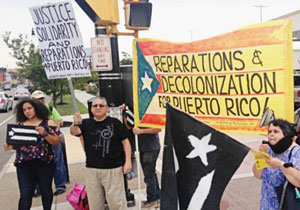 The one year anniversary of Hurricane María was met with demonstrations and memorials all across Puerto Rico as well as in the U.S. People came together to salute their own efforts in recovery and rebuilding and to condemn the continued government failure to meet the rights of the people, by the U.S. first and foremost. The U.S. failed to provide the needed assistance and emergency recovery operations at the time of the hurricane and has since refused to fully fund the recovery. As a result there were thousands of unnecessary deaths — something the U.S. denies. And continuing problems with healthcare, education, electricity, clean water and more. What has been done, such as privatizing the power authority and hundreds of public schools has been dictated by the U.S. imposed unelected Control Board. The Board continues to make paying the debt to the Wall Street loan sharks the priority. This insistence on paying the debt and imposing brutal attacks on the people, their jobs, pensions, schools and hospitals, ensured that Puerto Rico was not prepared for a hurricane of Maria's magnitude and that recovery remains far from complete.
The one year anniversary of Hurricane María was met with demonstrations and memorials all across Puerto Rico as well as in the U.S. People came together to salute their own efforts in recovery and rebuilding and to condemn the continued government failure to meet the rights of the people, by the U.S. first and foremost. The U.S. failed to provide the needed assistance and emergency recovery operations at the time of the hurricane and has since refused to fully fund the recovery. As a result there were thousands of unnecessary deaths — something the U.S. denies. And continuing problems with healthcare, education, electricity, clean water and more. What has been done, such as privatizing the power authority and hundreds of public schools has been dictated by the U.S. imposed unelected Control Board. The Board continues to make paying the debt to the Wall Street loan sharks the priority. This insistence on paying the debt and imposing brutal attacks on the people, their jobs, pensions, schools and hospitals, ensured that Puerto Rico was not prepared for a hurricane of Maria's magnitude and that recovery remains far from complete.
Planning, for evacuations, back up generators and supplies for hospitals, alternate sources of energy like solar, as well as for recovery was not done. Instead people were left to fend for themselves. While many thousands of needless deaths occurred as a result of government failure, people refused to accept the situation. Instead they rose to the occasion, made repairs themselves, organized to rebuild and to resist the on-going attacks. While conditions are still difficult and dangerous for many, the spirit and culture of resistance Puerto Ricans are known for has stood out.
This includes two one-day strikes by teachers, one in March and another at the start of the school year in August. School closures began before the hurricane and have intensified since. Government officials in Puerto Rico and facts on the ground are making clear that the closures are to undermine the teachers' resistance while also securing the best buildings for privatization, for charter schools or other purposes. As Puerto Rico's Secretary of Education Julia Keleher put it, commenting on the more than $500 million in public dollars for privatization, “No one wanted the storm. But I am not going to misspend the opportunity, pardon the pun, that I have to redirect these things that would have never been available to Puerto Rico. [Without the storm], I would have been short $300 million.”
Teachers, parents and students have continued their resistance, including occupying one of the schools that served a large number of special needs children. Puerto Rico only has one charter school at present, but, like New Orleans, the hurricane is being used as justification to greatly increase that number. The closure of hundreds of public schools that are in good condition and well-staffed is an indication of how far government officials intend to go. This direction was instigated and fully supported by the unelected Control Board, whose hedge fund enforcers directly benefit from privatization.
In addition to actions on the anniversary of María, there were also many a few days later on September 23, the 150th anniversary of El Grito De Lares, also known as the Lares Revolution. In 1868, enraged by the continuing colonial repression on the island, Puerto Rico’s pro-independence movement organized an armed rebellion. This firm stand against colonialism, then against the Spanish, today against the U.S., runs through Puerto Rico's long culture of resistance.
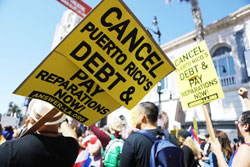 U.S. colonialism is the main source of Puerto Rico's difficulties and includes crimes of genocide, sterilization of women, terrorizing resistance, massive damage to the human and natural environments, undemocratic dictate, including the Control Board, and military occupation. This included the Navy using Vieques as a bombing range, which was defeated and the Navy driven out by sustained organized resistance. The same is true of the fight to free Puerto Rico’s political prisoners. Both are examples of the resistance to colonialism and the demand in Puerto Rico and the U.S. for independence now!
U.S. colonialism is the main source of Puerto Rico's difficulties and includes crimes of genocide, sterilization of women, terrorizing resistance, massive damage to the human and natural environments, undemocratic dictate, including the Control Board, and military occupation. This included the Navy using Vieques as a bombing range, which was defeated and the Navy driven out by sustained organized resistance. The same is true of the fight to free Puerto Rico’s political prisoners. Both are examples of the resistance to colonialism and the demand in Puerto Rico and the U.S. for independence now!
In salute to Grito de Lares and the fight today for independence, let all stand as one against U.S. colonialism and for Puerto Rico Libre!
Cancel the Debt! Eliminate the Control Board! [TOP]
Reparations Now for 120 years of U.S. Colonialism!
The Preventable Deaths of Hurricane María
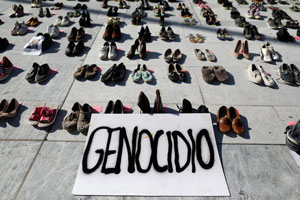 Four hundred and eighty seven stories of extreme and inhuman suffering, each one with its own name, prove that many of the deaths caused by Hurricane María could have been avoided, while revealing the causes that led to this historic rise in mortality in Puerto Rico.
Four hundred and eighty seven stories of extreme and inhuman suffering, each one with its own name, prove that many of the deaths caused by Hurricane María could have been avoided, while revealing the causes that led to this historic rise in mortality in Puerto Rico.
The latter is evidenced by the only comprehensive record available of the deaths related to the hurricane, documented by a joint investigation of the Center for Investigative Journalism (CPI), Quartz (QZ) and Associated Press (AP). The existing list is that of the government of Puerto Rico which still includes only 64 deaths.
Meanwhile, U.S. President Donald Trump — who has downplayed the magnitude of the catastrophe since the beginning and glorified his response level said recently that the estimate of deaths of more than 3,000 validated by the government of Puerto Rico and produced by George Washington University (GWU) is yet another fabrication from Democrats to make him look bad. [...] “3000 people did not die in the two hurricanes that hit Puerto Rico. When I left the Island, AFTER the storm had hit, they had anywhere from 6 to 18 deaths. As time went by it did not go up by much. Then, a long time later, they started to report really large numbers, like 3000…” he tweeted.
For about four hours, President Trump visited Puerto Rico on October 3, almost two weeks after the storm. According to the mortality statistics of the Puerto Rico Demographic Registry, from September 6 to the time of Trump’s departure, 640 people had died in excess of the average number of deaths during that same period in the previous three years.
One year after Hurricane María, the risk of seeing this tragedy repeat itself is real as systemic failures in access to health services and infrastructure — which caused the majority of deaths — have not been corrected, according to experts interviewed, and also admitted by Puerto Rico Governor Ricardo Rosselló. [...]
The investigation showed that the debacle in the three months that followed the hurricane was of such magnitude that it changed the face of death in Puerto Rico, modifying the island’s demographics and main causes of death. The investigation also included an analysis of the Demographic Registry’s mortality databases and thousands of death certificates obtained following a lawsuit filed by the CPI to obtain access to that information.
According to the data, the segment in which most deaths were recorded for the entire population, during the three months following the hurricane, was that of young adults of productive age, 30 to 44, with a percentage increase between 23% to 39%, compared to the average of the previous three years. This contrasts to the widely believed, government-backed perception that elderly people and those with pre-existing medical conditions were the ones who mostly died. Deaths among people over age 70, although more in net numbers, as they usually are, increased between 8% to 10%.
Many Deaths Preventable
 Sepsis, which has never been among the 10 leading causes of death in Puerto Rico — according to the Centers for Disease Control & Prevention (CDC) — was the eighth leading cause of death during the period examined. Dozens of stories of victims’ relatives tell how people bedridden and with diseases not related to the hurricane, such as bedsores or even a cavity, ended up dying of sepsis due to the unsafe and unhealthy temperatures and conditions that prevailed in hospitals, as well as the lack of treatment.
Sepsis, which has never been among the 10 leading causes of death in Puerto Rico — according to the Centers for Disease Control & Prevention (CDC) — was the eighth leading cause of death during the period examined. Dozens of stories of victims’ relatives tell how people bedridden and with diseases not related to the hurricane, such as bedsores or even a cavity, ended up dying of sepsis due to the unsafe and unhealthy temperatures and conditions that prevailed in hospitals, as well as the lack of treatment.
Among them is Ramona González Muñoz, who died in her home of bedsores at age 59 after being denied treatment in three hospitals, according to her relatives. The woman, who was bedridden two years ago with a degenerative brain disease, developed bedsores following Hurricane María, when she could not turn on the air conditioning in her room due to lack of power. She was taken twice to hospitals in San Juan, but in both instances she was discharged without being treated because the institutions could not handle the amount of patients. [...]
Other causes of death that saw significant increases, from 20% to 45%, were pneumonitis due to solids and liquids, primary hypertension and kidney disease, pneumonia and influenza, and respiratory, Alzheimer’s and heart diseases. Suicides, which are grouped under a category called “other causes,” registered an increase of 43.9%.
Among young adults ages 30 to 44, the causes suggest accidents and heart attacks, according to a review of death certificates and the CPI-QZ-AP registry. A fifth of these deaths are still under investigation. “These are deaths that could have been avoided,” said Dr. Cruz María Nazario, an epidemiologist and professor at the Medical Sciences Campus of the University of Puerto Rico. She is also one of the researchers of the GWU mortality study.
Dr. Irwin Redlener, director of the National Center for Disaster Preparedness at Columbia University in New York, agreed that the deaths could have been prevented with better preparedness and response to the emergency. He argued that the response to the disaster by the Puerto Rico and U.S. governments was extremely unsuccessful, although in many cases there were pre-existing conditions that affect mortality and resilience, such as a high level of poverty, lack of access to health services in Puerto Rico and no adequate preparation to face the storm.
Nazario explained the increases in the sepsis and pneumonia and influenza categories are particularly interesting as they do not correspond to diseases or diagnoses that people had before the hurricane, but rather to circumstances that arose due to the total collapse of the health system of Puerto Rico and that, in essence, are preventable. “These two diseases have served as sentinel death causes that we must continue using in future events because they give us a very quick idea that there is a problem that must be addressed urgently,” she said.
In the case of chronic diseases, such as respiratory and kidney diseases, Nazario emphasized that most patients live if they receive their medications and treatments, which ceased to occur for weeks and months after the storm, victims’ family members told the CPI-QZ-AP alliance. In dozens of cases, victims’ relatives attribute the death to the lack of dialysis, insulin or oxygen. In total, 300 people in the sample died of chronic diseases, such as diabetes, cancer and Alzheimer’s.
That was the case of Orlando López Martínez, 48. He has received dialysis treatment since 2014 as a result of diabetes, which he developed at age 11. In the aftermath of María, he lost at least four treatments because the Atlantis center in Aguadilla — where he received dialysis treatment four and a half hours a day, three times a week — was shut down. When it reopened, it did so by rationing services because it lacked enough fuel and water, so López started receiving only two hours of dialysis in each session.
He died on October 10. The official cause of death listed on his death certificate was a heart attack caused by kidney disease. It says nothing about Hurricane María or the lack of adequate treatment. [...]
The qualitative and detailed information provided by the victims’ relatives to the CPI, QZ.com and AP — known as “verbal autopsies”— is of great importance, Nazario said. It is the only source of information that exists about the mechanisms that triggered the clinical causes of death documented by the Demographic Registry and that go to the heart of the relationship between the increase in deaths and the hurricane, as the case of López demonstrates.
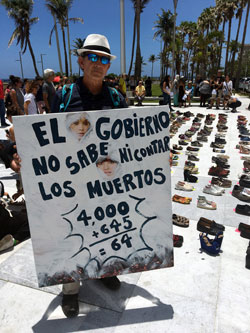 Among them are the lack of oxygen, electricity and water in hospitals and treatment clinics such as those for dialysis and chemotherapy; problems with communications and emergency transportation; anxiety and depression; and all kinds of accidents linked to disaster management efforts and deficiencies of basic services such as lack of power in homes and traffic lights on the roads. In the CPI-QZ-AP registry, death reports due to accidents are twice the number of those registered among the general population. [...]
Among them are the lack of oxygen, electricity and water in hospitals and treatment clinics such as those for dialysis and chemotherapy; problems with communications and emergency transportation; anxiety and depression; and all kinds of accidents linked to disaster management efforts and deficiencies of basic services such as lack of power in homes and traffic lights on the roads. In the CPI-QZ-AP registry, death reports due to accidents are twice the number of those registered among the general population. [...]
Three weeks after Hurricane, Saúl Pabey Martínez, 27, died in Peñuelas trying to connect a friend’s home to the power grid. Martínez was electrocuted and fell. A week later, Juan Gabriel Valentín Fuentes went to the house of his boss, Ramón Edwin Colón, to cut down a tree that María had knocked down onto the patio. One of the branches fell on him and went through his heart, killing him.
Valentín was 32 years old. On November 5, Kenny Huertas, 30, suffered a fall while helping his neighbors clean up debris. He died that day as a result of the accident.
“That is very valuable because those are possibly the causes of death that the Demographic Registry will never record as related to the hurricane. The value of the sample is precisely in these stories that detail the circumstances that triggered or aggravated the health problem that ended in the clinical death, which is what shows up in the Registry,” said Nazario about the increase recorded in the sample of deaths from accidents.
The systemic failures that sparked the deaths respond to negligent acts by both the Puerto Rico and federal governments, as well as the hospital industry, which at the time of María’s landfall, did not meet the standards of planning and preparation to adequately deal with the disaster. All these factors are among the reasons for the high mortality. [...]
Government Failures Responsible
Six months before the hurricane, the commonwealth government consolidated all the emergency response agencies within the newly created Department of Public Security (DSP), led by Secretary Héctor Pesquera. It merged under a single leadership important dependencies that historically have had autonomy, such as the Puerto Rico Police, the Medical Emergency Corps, the Institute of Forensic Sciences (now the Bureau of Forensic Sciences), the State Agency for Emergency & Disaster Management (now NMEAD) and the Fire Department. Puerto Rico’s Health Department was not part of the merger, yet it was also subject to Pesquera’s command during the emergency. Former directors of NMEAD, such as Epifanio Jiménez and Ángel Crespo, have strongly criticized the change, saying that the move affected the government’s response capacity in the face of the crisis.
Nazario argued this was negligent from a public health point of view, changing everything at once without having an alternative plan. “The problem was systemic, it is not that it failed here and there, it is that everything failed at once. Why? In part because everything was overthrown and deconstructed at the same time,” she said.
NMEAD announced on September 1 that it has a new emergency operational plan ready, but refused to provide a copy of the document on the grounds that it is “confidential.” The emergency plans of all the states devastated by natural disasters during the past decade —Florida, Texas, New York, California and Louisiana— are all public and available on the Internet.
“I have not seen the plan. I believe that if there is a plan, the first thing that must be done is to disclose it and, above all, to circle it in those agencies that can provide feedback and improve it or correct it. It is not to keep it in a drawer of Pesquera’s office so that he can say there is a plan,” said Nazario, the epidemiologist.
 The Department of Health also did not have a public health emergency response plan to tell health institutions and patients how to respond to a disaster and where to go. Waddy González, a FEMA official in charge of the health component in Puerto Rico, said in an interview that Health Secretary Rafael Rodríguez Mercado has prepared such a plan, but that it has not been made public to the hospital industry and citizens. Rodríguez Mercado refused to be interviewed for this story and did not respond to multiple requests to provide a copy of this plan.
The Department of Health also did not have a public health emergency response plan to tell health institutions and patients how to respond to a disaster and where to go. Waddy González, a FEMA official in charge of the health component in Puerto Rico, said in an interview that Health Secretary Rafael Rodríguez Mercado has prepared such a plan, but that it has not been made public to the hospital industry and citizens. Rodríguez Mercado refused to be interviewed for this story and did not respond to multiple requests to provide a copy of this plan.
The consequence of dismantling emergency response institutions and lacking adequate response plans was that, after the storm, local and federal agencies did not react with the agility and forcefulness needed to protect citizens, who died by the hundreds, usually for preventable causes.
Most of these deaths occurred in hospitals, which experienced an increase in mortality of 32.3% and were practically inoperative, without electric service, without generators or with deficient ones, and without fuel reserves to operate, according to several testimonies and visits made. The Department of Health, the agency that inspects hospitals and licenses on behalf of the Centers for Medicare and Medicaid (CMS), acknowledged that it does not have the resources to timely perform this function and has refused to provide evidence of visits to the facilities after Hurricane María. CMS also failed to provide the documents despite multiple requests for this information.
“Maybe in the future we would need a policy that requires that in order to obtain a certification or license to operate [a hospital], you have to be able to mitigate a Category-5 hurricane. For example, you have to have generators, ready, with several days of supplies,” said Alexis Santos, a demographer from the Pennsylvania State University who has extensively analyzed death statistics after Hurricane María. He noted that the data serves to identify failures and create public policy that corrects them and prevents deaths during the next emergency.
Jaime Plá, executive president of the Puerto Rico Hospital Association, minimized the faults of these health facilities during an interview, as he attributed the increase in deaths to the idea that people with chronic conditions — desperate for the lack of power in their homes, nursing homes or dialysis clinics — practically “came to die in hospitals.” Although the evidence proves that, in effect, all the components of the health system failed, from pharmacies to Puerto Rico’s Medical Center, it also demonstrates fatal flaws in the operation of hospitals.
U.S. Government Crimes
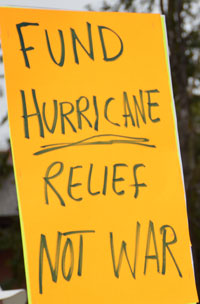 While he acknowledged that the mistakes made by the Puerto Rico government in preparing and responding to the emergency were enormous, Redlener, director of the National Center for Disaster Preparedness at Columbia University, placed the greatest weight of responsibility on the U.S. government, which having the resources to respond in time and with the strength needed to avoid deaths, failed to do so.
While he acknowledged that the mistakes made by the Puerto Rico government in preparing and responding to the emergency were enormous, Redlener, director of the National Center for Disaster Preparedness at Columbia University, placed the greatest weight of responsibility on the U.S. government, which having the resources to respond in time and with the strength needed to avoid deaths, failed to do so.
Redlener added that the U.S. government was “negligent” in not sending to Puerto Rico the resources and aid that the scale of the disaster called for. He argued that although the U.S. Army has the ability to reestablish communications, establish temporary electrical systems, rebuild bridges and ensure medical transportation better than any other agency, “it was not activated and deployed on time or at the level that should have been done. This was an inexcusable failure of the U.S. Army,” Redlener stressed. [...]
Redlener added that, now in the recovery phase, he sees the same inconsistency between the real scale of the catastrophe and the resources that are being allocated for reconstruction, as well as the way in which Congress is setting budgetary priorities well below what is required. Congress has approved more than $140 billion in recovery funds for areas hit by natural disasters in 2017. To access them, Puerto Rico has to compete with other affected jurisdictions, including Texas, Florida and California. Federal funds that have been allocated directly to the island, about $16 billion, represent a fraction of what the Rosselló government says it needs. For example, according to his calculations, repairing Puerto Rico’s electricity system would cost $17 billion. So far, Puerto Rico has only secured $2 billion from the federal government for this.
The increase in mortality in Puerto Rico after Hurricane María and the denial of this reality by the government of Puerto Rico were first revealed by the CPI on September 28, 2017. Ever since that publication, the CPI, international media and academics have continued to investigate the situation, producing estimates of excess mortality that greatly exceeded the government’s official number of certified deaths. Death toll estimates range from 800 to 8,500 deaths, the range determined by a Harvard University study published in May, which sparked a massive protest by citizens, many of whom left empty shoes in front of the Capitol in San Juan in honor of their loved ones who died because of the hurricane.
Three weeks before María’s one-year anniversary, the government of Puerto Rico finally adopted the 2,975 figure of the GWU study it commissioned as its “official estimate” of victims. However, this estimate, as well as the other excess mortality figures that have been published to date, are only mathematical computations that do not correspond to real victims of the disaster, do not list the names of the deceased nor talk about the reasons that led to the deaths.
In contrast, the CPI-QZ-AP alliance documented the stories of 487 people who died during the emergency, told by their families and corroborated with interviews, documents and data from the Puerto Rico Demographic Registry. This puts a face to the victims. The deaths listed in the registry verified by the three media outlets would be linked to the hurricane under CDC parameters. These include deaths due to the physical forces of the hurricane, such as landslides or floods; they also take into account those associated with the consequences of the storm, such as the lack of medical services, unhealthy conditions and stress. [...]
When it comes to saving lives, disaster preparedness plans for the short, medium and long term and developed with the input and participation of the communities are key, said Dr. Jennifer Horney, director of the epidemiology program at University of Delaware.
A year after María, the conditions for health care, clean water and more remain dangerous for many.
[TOP]
